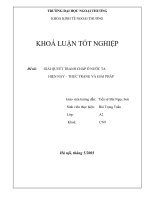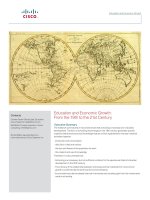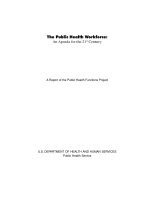Managers'''' manual for the 21st century ppt
Bạn đang xem bản rút gọn của tài liệu. Xem và tải ngay bản đầy đủ của tài liệu tại đây (87.23 KB, 10 trang )
Managers' manual for the 21st century.
Balancing Innovation and Time-Tested Practices
By Kehinde Fawumi
(Author of Tomorrow's Realities Today and Once Upon an Incorruptible Criminal)
Published by Kehinde Fawumi at Smashwords.
Discover other titles by Kehinde Fawumi by visiting his Smashwords Author Page.
Copyright © 2012 Kehinde Fawumi
Thank you for downloading this Ebook. This book remains the copyrighted property of
the author and may not be reproduced, copied and distributed for commercial or non-
commercial purposes. If you enjoyed this book, kindly refer your friends to download
their own copy at Smashwords.com, where they can also discover other works by this
author.
Balancing Innovation and Time-Tested Practices
The advent of the 21st century heralded numerous uncertainties, many of which the
global community is still battling or better still, adapting to in hope of finding lasting
panaceas. Employers are daily confronting the unprecedented dynamics of globalization
and unfavourable economic fluctuations. Many questions are being asked as to whom
to blame: the government, the private sector, the youth, or nature? While trying to focus
on the solutions, some economic experts have asked more critical questions as to what
a lasting solution will entail.
Building on the predicament of the prevalent challenges, a more critical issue will be
that of economic inconsistencies, of how the challenges of this decade may likely differ
largely from those of the next; leaving the globe is state of dilemma, with just one single
question: What ideas will work for tomorrow? Creativities are being birthed; ones that
come from reasonable senses of destiny, new innovations and inventions emanate
everyday creating more possibilities, but are these able to create the all-awaited
changes the world deserve?
My purpose in these pages is simple; to share my ideas on how entrepreneurs and
government should balance innovation and creativity while leveraging time-tested
practices to bring about sustainable changes to the greatest political and socioeconomic
problems in the world. I intend to underline the simplicity of the seemingly complex
socioeconomic threats of the next society – an adventure and a stream of symbolic
tales of strategic managers. If I do it well—and I will do my best—I believe I will
emphatically define the boundaries of the limitless economic progressions – at least for
the next two decades.
As much as I do not belabour the undeniable importance of the prevalent management
and business principles, It is important that we consider these principles within the
contexts of socioeconomic diversity and sustainability.
Let me say upfront that although acceptance and implementation of prevalent
management concepts like Scope, Time and Cost Management, Quality Control,
Human Resource Management, Strategic Process Integration and Risk Management
has led to tangible socioeconomic developments on a global basis; they may not stand
the unpredictable economic challenges of the next decade. The recent economic slump
is an obvious proof! There’s thus an urgent need for the intervention of business
strategists and economists to specify strategic methodologies which will sustain our
world in the next generation.
There may be no need for new methods but applying existing ones in new ways. More
critically, the paradigm of perceiving business as a profit-making venture has to be
reviewed, and a value-creation perception towards sociopolitical development upheld!
Should business not be concerned with making profits? Absolutely No! But profits
should not form the basis of business creation. This paradigm has for long hobbled the
economic development of most developing countries and now must stop for a better
future.
A new discovery is not in seeing new landscapes, but having new eyes.
With due allowance for the vast difference between a critical issue and a tale, I wish to
symbolically establish that our perception rather than economic realities has affected
the economic situation in our nations.
He was bitter and cruel, an alcoholic and drug addict who almost killed himself several
times. Today he serves a life sentence in prison for the murder of a liquor store cashier
who “got in his way.” He has two sons, born mere eleven months apart, one of whom
grew up to be “just like Dad”: a drug addict who lived by stealing and threatening others
until he, too, was put in jail for attempted murder. His brother, however, is a different
story: a man who’s raising three kids, enjoys his marriage, and appears to be truly
happy. As a regional manager for a major national concern, he finds his work both
challenging and rewarding. He’s physically fit, and has no alcohol or drug addictions!
How could these two young men have turned out so differently, having grown up in
virtually the same environment? Both were asked privately, unbeknownst to the other,
“Why has you life turned out this way?” Surprisingly, they both provided the exact same
answer: “What else could I have become, having grown up with a father like that?
(Anthony Robbins: Awaken the Giant Within)
So often we’re seduced into believing that events control our businesses; that our
environment has shaped who we are today. No greater lie was ever told! It’s not the
events of our lives, or nation that shape us, but our beliefs as to what those events
mean. Today, any young manager, or a start-up business might be an unfortunate son.
Lamenting over the situation won’t change the reality—not for the better, nor for the
worse. But by changing how we focus on a problem we can awaken our creativity and
pursue a sustainable methodology to solving the problem, and who knows? That shift in
perspective may uncover the solution! I believe a fundamental change we need for the
next generation is a radical shift in our perspective and approach to interpreting and
solving the volatile economic problems.
So, what will change really entail?
The present generation of social, economic and political leaders as well as managers,
must provide the necessary foundations for achieving the developments that are
intended to be seen in the next generation. Under this framework, and given the need
for future leaders to move from ideas to action, there must be a pragmatic approach to
our situations. Thus, the kind of approach we employ in confronting our present
challenges will indicate the changes we will experience in the nearest future.
We must invent new Qualitative approaches rather than Quantitative ones!
How can we build reputation for our products in the face of unresponsive masses? I
suggest by first building a reputation for the quality of the products, then providing
numerous references to reinforce the beliefs of the people – even to the point that
people no longer question its validity. It may surprise you that Japanese commitment to
increasing quality is actually the result of an American export – Dr. W. Edwards Deming.
In 1950 this renowned quality-control expert was brought to Japan by General
MacArthur, who was frustrated with a war-ravaged Japanese industrial base where he
couldn’t even count on being able to complete a phone call. At the request of the
Japanese Union of Scientists and Engineers, Deming began to train the Japanese in his
total quality control principle. Deming taught the Japanese 14 principles and a basic
core belief that is the foundation of virtually all decisions made in ever successful,
major, multinational Japanese corporation to this day.
The core belief simply is this: a constant, never-ending commitment to consistently
increase the quality of their business every single day would give them the power to
dominate the markets of the world. Deming taught that quality was not just a matter of
meeting some certain standards, but rather was a living, breathing process of never-
ending improvements. If the Japanese would live by the principles he taught them, he
promised them, within five years, they would flood the world with quality products and
within a decade, or two become one of the world’s dominant economic powers.
Many thought Deming’s proclamations were crazy. But the Japanese took him at his
word, and today, he is revered as the “Father of Japanese Miracle”. In fact each year
since 1950, perhaps the highest honour a Japanese company can receive is the
National Deming Price. This award is used to acknowledge the company that
represents the highest level of increases in quality of products, service, management,
and worker support through Japan.
In 1983, Ford Motor Company hired Dr. Deming to conduct a series of management
seminars. One of the attendees was Donald Petersen, who later become chairman of
Ford and put Deming’s principles into practice throughout the company. Petersen
decide “We need this man to turn our company around." At the time, Ford was losing
billions of Dollars a year. Once Deming was brought in, he changed the traditional
corporate belief from: “How can we increase our volume and cut our cost?” to “How can
we increase the quality of what we are doing and do it in such a way that the quality
would not cost more in the long term?” Ford reorganized its entire focus to make quality
the top priority, and by implementing Deming’s systems, Ford within three years moved
from a staggering deficit to the dominant industry position with a $6 billion profit.
How did they do it? They found out that the Americans’ perception of Japanese quality,
while frustrating, had much to teach them. Why did these Japanese companies hold
themselves to a higher standard of quality than even their contract required? They
believed that quality costs less, that if they created a quality product they would not just
have satisfied customers, but loyal customers – customers who would be willing to wait
in line and pay more money for their products. They were operating from the same core
belief that propelled them to one of the top market positions in the world: a commitment
to never-ending improvements and a constant increase in the quality of products and
services and thus, life of their customers. This belief was an American export – one I
believe managers need to repatriate in order to change the direction of our nations’
economic future.
The best way to predict future is to create it! – Peter F Drucker.
We are responsible for what we are, and whatever we wish ourselves to be, we have
the power to make ourselves. If what we are now has been the result of our own past
actions, it certainly follows that whatever we wish to be in future can be produced by our
present actions; so we have to know how to act! I hereby propose three critical ideas
that should be employed in order to create the change we desire for the next society.
First is the concept of synergy in relation to the social sector and the opportunities
generated by taking it into action. The creation of a social network in a community is a
key factor into getting greater results of the projects created within it than those
achieved while working individually. Managers must thus begin to collaborate in order to
harness the strengths of synergy. The generation of social synergic systems can
encourage many necessary changes and growth at local levels, and also has the
potential to act as the basis for integration at the level of countries and regions. Among
the most successful synergetic systems, endeavors such as “Facebook”, “Google”,
"Wikipedia" and "Microcredit" - created by Muhhamad Yunus in Bangladesh, can be
named. We must ask - in what ways can these successful cases be emulated and
repeated?
A second concept is the creation of sustainable businesses. Managers must keep a
mind of businesses with measurable social relevance. This can be studied from the
Triple Bottom Line theory based on the company’s self-recognition as a social actor and
its ability to respond to the economic, social and environmental impact in its activities in
the long run. Three pillars are identified: a fair and beneficial practice in the community
and region in which business is carried on, a positive impact, or at least not harmful for
the environment, and the consideration for the “real” economic value created by the
company taking into account the costs in human and natural capital as well as social
and environmental benefits to the surroundings.
An example of this type of business is the Brazilian cosmetics company Natura, which is
defined as a "zero carbon" firm because it offers products produced with a neutral
emission of greenhouse gases. Another example might be the case for Coop Konsum,
a Swedish supermarket chain oriented towards the sale of organic products. In recent
years, Coop Konsum has stopped selling eggs from hens grown in overcrowded
hatcheries, which lead to poor living conditions. We must be committed to creating more
examples like these in the world?
Thirdly, one toxic belief that may be destroying our economic strength is what I call
managing by the visible numbers: the conventional corporate belief that profits are
made by cutting costs and increasing revenues. A notable example occurred when Lynn
Townsend took charge of Chrysler during an industry-wide sales slump. Townsend
immediately tried to increase revenues, but more importantly, he cut costs. How? He
fired two-thirds of the engineering staff. In the short term, it looked like he’d made the
right decision. Profitably shot up, and he was dubbed a hero. But, within a few years,
Chrysler was again in financial straits. What happened? Well, there certainly wasn’t any
factor. But in the long term, the decisions Townsend made may have been destroying
the basis of quality upon which the company’s success depended. Often, the very
people who are injuring our company may be rewarded because they produce results in
the short term. Sometimes we treat symptoms of a problem while we nurture the cause.
We have to be careful how we interpret results. By contrast, one of the most important
factors in turning Ford Motor Company around was their design staff, who came up with
a new car called Taurus. The quality of that car set a new standard for Ford, and
consumers bought it in droves. Managers must thus be able to determine what the
successes of their business anchors on, and must protect it diligently.
In other words management approaches must begin to focus on the People, the Planet,
and then Profit, what I call the 3P Concept.
Strategic People Manipulation - a Management Concept!
We must know how to use the people to get what we need from them. As much as we
develop our businesses with a mindset of improving our nearest community, we must
also understand that the future sustainability of the businesses is dependent on the
profit margin realized from every single successful project. And this is possible if the
people are ably manipulated - to buy into our businesses!
Some advertisers clearly understand this. They know that what drives us people is not
so much our intellect as the sensations that we link to their products. As a result, rapid
and elegant imagery, bright or subdued color, and a variety of other elements to put us
in certain emotional states are presented at first; then, when our sensations are most
intense, they flash an image of their products continuously until we link it to these
desired feelings.
Pepsi employed this strategy brilliantly in carving out a bigger share of the lucrative soft-
drink from their major competitior, Coca-cola. Pepsi observed the phenomenal success
of Michael Jackson, a young man who has spent his entire life learning how to heighten
people’s emotions by the way uses his voice, his body, his face and his gestures.
Michael sang and danced in a way that stimulated huge numbers of people to feel
incredibly good – so much so that they will often purchase his albums to re-create these
feelings. Pepsi asked, how can we transfer those sensations to our products? This is
clever – if people associate the same pleasurable feelings to a bottle of Pepsi, as they
do Michael Jackson, they’d buy Pepsi just as they bought his albums.
The process of anchoring new feelings to a product or idea is the integral transference
necessary to basic conditioning. This is how they achieved their aim. First, Pepsi used
Michael Jackson to get the people to the peak of their emotional state. Then, at that
precise moment, they flashed their product. Continuous repetitions of this created an
emotional for hundred millions of Jackson’s fans. You may wonder, “Isn’t this company
crazy? They hired a guy for $10million to represent them who doesn’t even drink their
product! What kind of a spokesperson is this? What a crazy Idea!” Actually, it was a
brilliant Idea. Sales went through the roof – so high that L.A Gear then hired Michael for
$20million to represent their product.
We’ve got to realize that this strategy is psychological! It is all based on making
customers linking pleasurable sensations to our products. If we use the product, we’ll
live our fantasies, they think! Advertisers in automobile companies have taught us that if
you drive a BMW, then you are an extraordinary person with exceptional taste. If you
drive Hyundai, you’re intelligent and frugal. If you drive a Pontaic, you’ll have
excitement. If you drive a Toyota, what a feeling you’ll get! You’re taught that if you wear
obsession cologne, you’ll soon be entwined in the throes of an androgynous orgy. If you
drink Pepsi, you’ll be able to jam with the M.C. Hammer is the epitome of hip. If you
want to be a good mom, then you feed your children Hostess fruit pies, cupcakes and
Twinkles.
This may sound trivial, or even silly; but if our “wise” approaches are not working, is it
not wise to try “foolish” ones? Every successful company that thrives till today can tell
stories of perceived-foolish steps they took, which turned out good in the long term. . .
Remember, we’re not driven by the reality, but by our perception of reality.
Conclusion
Our socioeconomic and political situations would not be what it is today, in the nearest
future – it will be worse, unless great leaps are made to create the foundations for the
changes we hope to experience in the next generation. We do not ultimately need new
strategies, but apply existing management process in the context of socioeconomic
relevance, continuity and sustainability. We must also be more creative than ever
before!
As Peter F. Drucker believes, and is perceived true, the best way to predict the future is
to create it. We have to act now in creating our future by our own hands, we must:
change our economic perspective by establishing sustainable business which are social
actors, improve the quality of our products rather than cut costs, enlist corporate help—
build a network of support for new ventures, collaborate by building social-networks and
strategically manipulate the people in order to attain business goals.
If you are ready to wait for eternity hoping things will become better – Good luck to you.
I will continue to dream and to build – until I see the change our world deserves. People
say I am a dreamer but I am not only one…I am also a dogged realist… hope someday
you join me and other folks that share my passion…to effect the change our world
deserves.
###
About the Author
Kehinde Fawumi is a result-oriented innovator and motivational speaker as well as a
prodigious writer. He has authored books which have been translated to other
languages and are being read all over the world. His remarkable experience in youth
leadership has inspired his vision to directly impact 5 million youths in the world in the
next 10 years.
He presently works with other youths across the world on different youth social projects.
He has authored several essays, many of which had been excellently awarded globally.
Kehinde is passionate about touching lives and inspiring people. He talks in
conferences and in diverse youth gatherings.
If you enjoyed this book, kindly mail your feedback/invitations to
I will be excited to read from you. You can also visit my website
on or call me on +2348067126935.









